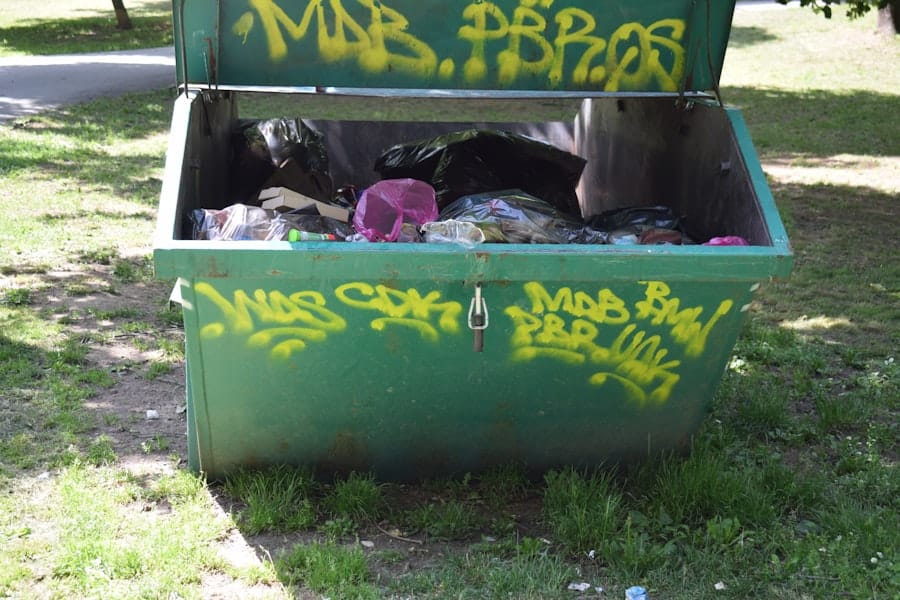In an era where environmental sustainability is paramount, the concept of smart waste sorting and management at home has emerged as a critical solution to address the growing waste crisis. Traditional waste disposal methods often lead to significant inefficiencies, with recyclable materials ending up in landfills due to improper sorting. Smart waste management systems leverage technology to enhance the efficiency of waste sorting, making it easier for households to contribute to recycling efforts.
By integrating advanced technologies, such as the Internet of Things (IoT), these systems not only streamline the sorting process but also promote responsible waste disposal practices among users. The integration of smart waste management solutions into everyday life represents a paradigm shift in how individuals interact with their waste. With the rise of urbanization and increasing population density, the volume of waste generated is escalating at an alarming rate.
Smart waste sorting systems aim to mitigate this issue by providing users with tools and insights that facilitate better waste management practices. This article delves into the role of IoT in transforming home waste management, exploring its benefits, challenges, and future trends that promise to revolutionize how we handle waste at the household level.
Key Takeaways
- Smart waste sorting and management at home is becoming increasingly popular as people seek more sustainable and efficient ways to handle their waste.
- The Internet of Things (IoT) plays a crucial role in waste management by connecting devices and sensors to enable smart waste sorting and monitoring.
- Implementing IoT in smart waste sorting at home brings benefits such as improved efficiency, reduced environmental impact, and cost savings.
- IoT devices and sensors aid in efficient waste management by providing real-time data on waste levels, sorting accuracy, and equipment performance.
- Data analytics and IoT work together to optimize waste sorting and recycling by providing insights into waste composition, trends, and potential improvements.
Understanding the Internet of Things (IoT) and its Role in Waste Management
The Internet of Things (IoT) refers to a network of interconnected devices that communicate and exchange data over the internet. These devices can range from everyday household items to complex industrial machinery, all equipped with sensors and software that enable them to collect and share information. In the context of waste management, IoT plays a pivotal role by providing real-time data on waste generation, composition, and disposal patterns.
This data-driven approach allows for more informed decision-making regarding waste sorting and recycling. IoT devices can be embedded in various components of a smart waste management system, such as smart bins equipped with sensors that detect the type and volume of waste deposited. These bins can communicate with users through mobile applications, providing feedback on their waste disposal habits and offering suggestions for improvement.
For instance, if a user consistently disposes of recyclable materials in the general waste bin, the system can send alerts or educational content to encourage better sorting practices. This feedback loop not only enhances user engagement but also fosters a culture of sustainability within households.
Benefits of Implementing IoT in Smart Waste Sorting at Home

The implementation of IoT in smart waste sorting systems offers numerous benefits that extend beyond mere convenience. One of the most significant advantages is the potential for increased recycling rates. By providing users with real-time information about their waste disposal habits, IoT-enabled systems can help individuals understand the importance of proper sorting and motivate them to recycle more effectively.
Moreover, smart waste management systems can optimize collection routes for waste disposal services. By analyzing data on bin fill levels and waste generation patterns, municipalities can adjust collection schedules and routes to minimize fuel consumption and operational costs.
This not only leads to more efficient waste collection but also reduces the carbon footprint associated with transportation. Additionally, by streamlining the collection process, cities can allocate resources more effectively, ensuring that waste management services are responsive to community needs.
How IoT Devices and Sensors Aid in Efficient Waste Management
IoT devices and sensors play a crucial role in enhancing the efficiency of waste management systems by providing accurate and timely data on various aspects of waste disposal. Smart bins equipped with weight sensors can measure the amount of waste deposited, allowing users to track their disposal habits over time. This data can be invaluable for households aiming to reduce their overall waste output or increase their recycling efforts.
For example, if a family notices that they are consistently generating a high volume of organic waste, they may choose to implement composting practices to divert that material from landfills.
This capability allows for automatic sorting of recyclables from general waste, significantly reducing contamination rates and improving the quality of recycled materials.
Furthermore, these bins can communicate with users via mobile applications, providing insights into their recycling performance and offering tips for better sorting practices. By gamifying the recycling process and providing tangible feedback, IoT devices can encourage households to adopt more sustainable behaviors.
The Role of Data Analytics and IoT in Optimizing Waste Sorting and Recycling
Data analytics is an integral component of IoT-enabled smart waste management systems, as it allows for the interpretation and utilization of the vast amounts of data generated by connected devices. By analyzing trends in waste generation and disposal patterns, municipalities and households can identify areas for improvement in their recycling efforts. For instance, data analytics can reveal which materials are most frequently misclassified or improperly disposed of, enabling targeted educational campaigns to address these issues.
Moreover, predictive analytics can be employed to forecast future waste generation trends based on historical data. This information can be invaluable for municipalities planning their waste management strategies, as it allows them to allocate resources more effectively and anticipate changes in community needs. For example, if data indicates a significant increase in plastic waste during certain seasons or events, municipalities can adjust their collection schedules or implement temporary recycling initiatives to accommodate this surge.
Challenges and Considerations in Implementing IoT for Smart Waste Management

Cost and Investment
One significant concern is the cost associated with deploying these technologies. Although prices for IoT devices have decreased over time, the initial investments in smart bins, sensors, and data analytics platforms can still be substantial for municipalities or households looking to adopt these solutions. Moreover, ongoing maintenance and software updates may incur further costs.
User Engagement and Compliance
Another challenge lies in ensuring user engagement and compliance with smart waste sorting practices. While technology can provide valuable insights and feedback, it is ultimately up to individuals to change their behaviors regarding waste disposal. Educational initiatives may be necessary to inform users about the importance of proper sorting and recycling practices.
Privacy Concerns
Furthermore, privacy concerns related to data collection must be addressed; users should be assured that their information will be handled responsibly and used solely for improving waste management efforts.
Examples of IoT-enabled Smart Waste Management Systems for Home Use
Several innovative IoT-enabled smart waste management systems have emerged in recent years, showcasing the potential of technology to enhance home recycling efforts. One notable example is the “Smart Bin,” which features built-in sensors that monitor fill levels and provide real-time notifications to users when it is time for collection or when specific materials are detected. This bin can also connect to a mobile app that offers personalized insights into recycling habits and provides tips for reducing waste.
Another example is “Recycla,” an intelligent recycling system designed specifically for households. Recycla utilizes image recognition technology to identify materials as they are disposed of, automatically sorting recyclables from general waste. The accompanying app tracks users’ recycling performance over time, gamifying the process by rewarding users for achieving specific milestones or reducing contamination rates.
These examples illustrate how IoT technology can transform traditional waste management practices at home, making it easier for individuals to engage in sustainable behaviors while contributing to broader environmental goals.
Future Trends and Innovations in IoT for Smart Waste Sorting and Management at Home
As technology continues to evolve, the future of IoT in smart waste sorting and management holds exciting possibilities. One emerging trend is the integration of artificial intelligence (AI) with IoT systems to enhance decision-making capabilities further. AI algorithms can analyze vast datasets generated by smart bins and sensors to identify patterns and optimize sorting processes automatically.
This could lead to even higher recycling rates and reduced contamination levels. Additionally, advancements in machine learning could enable smart bins to adapt over time based on user behavior, providing increasingly personalized feedback and recommendations for improving recycling practices. As more households adopt smart home technologies, we may also see greater interoperability between different devices, allowing for seamless integration of waste management systems with other smart home solutions.
Furthermore, as public awareness of environmental issues grows, there may be increased demand for community-based initiatives that leverage IoT technology for collective impact. Neighborhoods could implement shared smart bins that track community-wide recycling efforts, fostering a sense of accountability and collaboration among residents. In conclusion, the intersection of IoT technology and smart waste sorting presents a promising avenue for enhancing home recycling efforts while addressing pressing environmental challenges.
As innovations continue to emerge in this space, households will have access to increasingly sophisticated tools that empower them to make informed decisions about their waste disposal practices.
If you are interested in optimizing your home office setup for remote work, you may want to check out this article on finding the best laptop for remote work. Additionally, if you are looking to explore affiliate marketing opportunities on social media platforms like Pinterest or YouTube, you can read more about the best niches for affiliate marketing in Pinterest and YouTube.
FAQs
What is IoT?
IoT stands for Internet of Things, which refers to the network of physical devices, vehicles, home appliances, and other items embedded with electronics, software, sensors, and connectivity that enables them to connect and exchange data.
How does IoT contribute to smart waste sorting and management at home?
IoT technology can be used to create smart waste management systems at home by incorporating sensors into waste bins to monitor and sort different types of waste. These sensors can communicate with a central system to track and manage waste disposal, optimize collection routes, and provide data for analysis and improvement.
What are the benefits of using IoT for smart waste sorting and management at home?
Some benefits of using IoT for smart waste sorting and management at home include improved efficiency in waste collection, reduced environmental impact through better recycling practices, cost savings through optimized waste management, and the ability to track and analyze waste generation patterns for better decision-making.
What are some examples of IoT devices used for smart waste sorting and management at home?
Examples of IoT devices used for smart waste sorting and management at home include smart waste bins with sensors for sorting different types of waste, connected composting systems, and waste monitoring systems that provide real-time data on waste generation and disposal.
How can individuals implement IoT for smart waste sorting and management at home?
Individuals can implement IoT for smart waste sorting and management at home by investing in IoT-enabled waste bins or sorting systems, using connected composting systems, and leveraging waste monitoring devices to track and manage their household waste more effectively.

